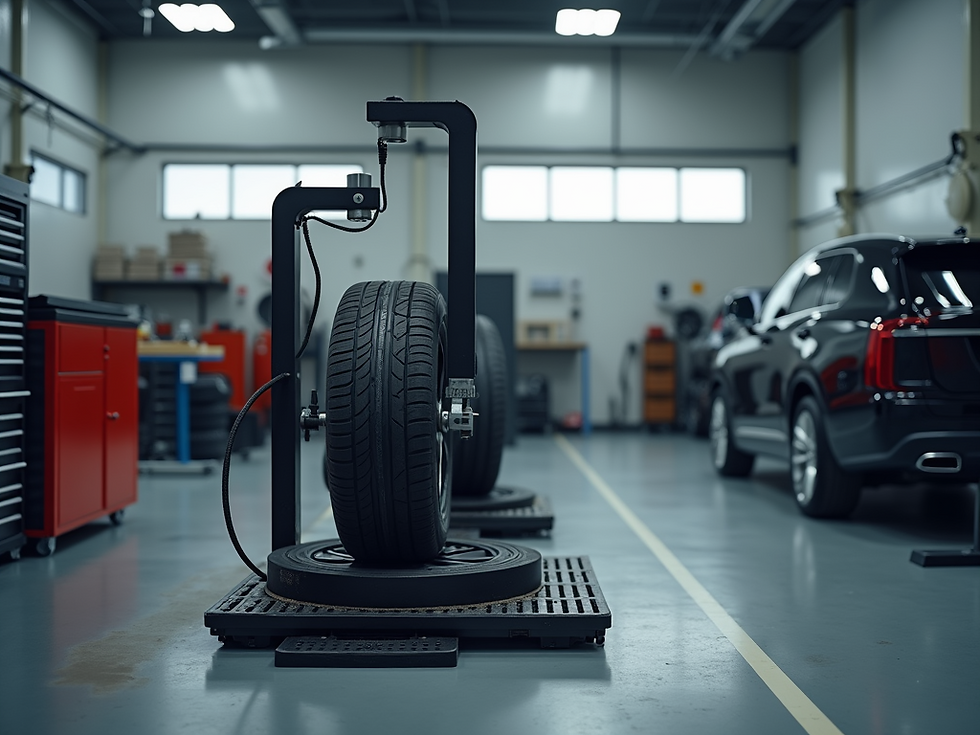The application of tire balancing machines in auto quick repair shops
- enze6799
- 13 minutes ago
- 3 min read
The Role of Tire Balancers in Quick Auto Repair Shops
Tire balancers are indispensable tools in quick auto repair shops, ensuring vehicles operate smoothly by addressing wheel imbalance issues. These devices play a critical role in enhancing safety, extending tire lifespan, and improving customer satisfaction. Below is an in-depth exploration of their applications, operational processes, and technological advancements.
Enhancing Vehicle Safety and Performance
Identifying and Correcting Imbalances
Tire imbalances occur when mass distribution is uneven, causing vibrations at high speeds. These vibrations can lead to steering wheel wobbling, uneven tire wear, and even structural damage to suspension components. Quick repair shops use tire balancers to detect imbalance points with precision, often within 1-gram accuracy. By adding calibrated weights to the lighter side of the wheel, technicians restore balance, ensuring the tire’s center of mass aligns with its rotational axis. This correction minimizes vibrations, reducing the risk of accidents caused by loss of control.
Supporting High-Speed Stability
Modern vehicles, especially those with advanced driver-assistance systems (ADAS), require precise wheel alignment and balance for optimal performance. Tire balancers help shops meet these standards by providing data-driven adjustments. For instance, a shop servicing a luxury sedan might use a balancer with laser-guided positioning to ensure minimal deviation, critical for maintaining the vehicle’s factory-set handling characteristics.
Streamlining Repair Workflows
Integration with Quick Service Protocols
Quick repair shops prioritize efficiency, often completing tire-related services in under 30 minutes. Tire balancers with automated features, such as self-calibration and quick-clamp systems, reduce setup time. Some models allow technicians to input wheel dimensions via touchscreens, automatically adjusting parameters for different vehicles. This automation enables shops to handle high volumes without compromising accuracy, appealing to time-sensitive customers like commuters or ride-share drivers.
Reducing Rework and Customer Complaints
Improper balancing is a common cause of post-repair vibrations, leading to customer dissatisfaction and return visits. By using balancers with real-time data displays, technicians can verify corrections instantly. For example, a shop might employ a machine that shows imbalance measurements in both static and dynamic modes, allowing dual-verification before releasing the vehicle. This reduces the likelihood of errors, enhancing the shop’s reputation for reliability.
Adapting to Technological Advancements
Smart Sensors and Cloud Connectivity
Emerging tire balancers incorporate IoT technology, enabling remote diagnostics and software updates. A shop in a remote area could receive firmware upgrades overnight, ensuring the machine operates with the latest algorithms for detecting subtle imbalances. Cloud-connected balancers also store service histories, allowing shops to track recurring issues for specific vehicles and offer proactive maintenance advice to customers.
Multi-Functional Designs for Diverse Needs
Quick repair shops often service a mix of passenger cars, SUVs, and light trucks. Advanced balancers feature adjustable cones and magnetic clamps to accommodate wheels ranging from 12-inch compact car rims to 24-inch off-road tires. Some models even support motorcycle wheel balancing, expanding the shop’s service portfolio. For instance, a shop near a motorcycle dealership might invest in a balancer with dedicated motorcycle modes, attracting a niche clientele.
Meeting Industry Standards and Compliance
Regulatory Requirements for Safety Inspections
In many regions, tire balance is part of mandatory vehicle inspections. Quick repair shops use certified balancers to ensure compliance with safety regulations. These machines often display calibration certificates and adhere to international standards like ISO 9001, providing documentation for audit purposes. A shop failing to balance tires correctly during inspections could face penalties, making reliable equipment essential.
Environmental and Ergonomic Considerations
Modern balancers are designed with sustainability in mind. Energy-efficient models consume less power during operation, reducing the shop’s carbon footprint. Additionally, ergonomic features like adjustable height stands and intuitive interfaces minimize technician fatigue, improving productivity. For example, a shop with limited space might opt for a compact balancer with a foldable design, optimizing workspace utilization.
By integrating tire balancers into their core operations, quick auto repair shops can deliver safer, more efficient services while staying competitive in a tech-driven market. These devices not only address immediate repair needs but also contribute to long-term customer loyalty through consistent, high-quality outcomes.





Comments